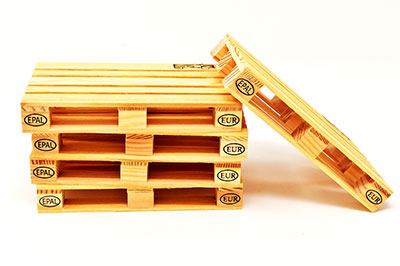 Here is our guide to pallets, which we hope will help you make an informed decision about which pallets are best suited to your products.
Here is our guide to pallets, which we hope will help you make an informed decision about which pallets are best suited to your products.
Standard pallets
In truth, there really isn’t such a thing as a ‘standard’ pallet. One region’s ‘standard’ will not match another’s. So when you are asking for Standard pallets, you need to know what is ‘standard’ to the region you are purchasing from.
UK Standard pallets
In the UK, Standard pallets measure 1200mm x 1000mm. The UK Standard comprises:
- UK Standard Grade 1 (also known as Grade A), which can hold up to approximately 1 tonne in weight.
- UK Standard Grade 2 (or Grade B), which can hold up to roughly 750kg.
- UK Standard Grade 3 (also called Grade C or Lightweight), which can bear between 200kg and 500kg.
There are also various terms which are applied in the UK to different types of pallets. These include:
- Perimeter-based pallets, where the pallets have large blocks and the top boards are close together. Perimeter-based pallets are the most suitable if they are to be stored in racking, because the base is flush to the surface it sits on.
- Three-legger pallets, where the pallet does not have any extra boards on the bottom, just the three legs for support.
- Conversion-based pallets – also known as raised pallets - which are three-leggers which have extra boards attached to the bottom for stability. These are not true perimeter-based pallets as they are not flush to the surface.
- Winger pallets, where the top boards overhang the blocks, in order to enable shrink-wrapping.
European Standard pallets
These differ in size to the UK Standard. Here, they are 1200mm x 800mm, so slightly smaller in width. As in the UK, there are a number of options available:
- Stamped Euro, where the pallets are heavy duty and carry the EUR stamp. All pallets carrying the EUR stamp are of an identical spec.
- Unstamped Euro, also known as unlicensed Euro. These also measure 1200mm x 800mm but will not be identical in spec and their load-bearing capacity will also vary.
- Half-Euro, which is also known as the Dusseldorf (a true Dusseldorf will have metal legs instead of timber blocks). This pallet measures 800mm x 600mm and is exactly half the size of a Euro pallet.
Global Standard pallets
On a global scale, there are six pallet sizes available which carry the ISO certificate. If your goods are to be shipped all over the world, it may pay to select one of these six types of pallet, and so avoid having to switch to the local size once they reach their destination.
The six ISO approved pallets are:
- 1219mm x 1016mm – common in North America
- 1200mm x 1000mm – used across Europe and Asia
- 1165mm x 1165mm – most commonly used in Australia
- 1067mm x 1067mm – used across North America, Asia and Europe
- 1100mm x 1100mm – most commonly used in Asia
- 1200mm x 800mm – most commonly used across Europe
Best of the rest
As well as the more common rectangular pallets, there is a range of square pallets, which in particular are used in North America.
You may also have heard of CP pallets, which again come in a number of sizes. These were developed for use by the chemical and construction industries. Unlike other pallets, the top boards are very closely spaced and are winged to both protect the blocks beneath and to enable shrink-wrapping. They come in nine sizes, CP1 – CP9.
Despite the huge variety of ‘standard’ pallets, you may still find you need something more bespoke, for your particular products. If this is the case, it is possible to have custom-made pallets.
And finally… pallet racking
Having got to grips with the terminology and sizing surrounding pallets, we would like to include a last word about pallet racking.
If you are planning to invest in a warehouse storage solution, it may be useful to understand the following commonly used terms:
Uprights: these are the vertical struts into which the pallet racking beams connect. Uprights come in differing heights and with differing load capacities.
Frames: two uprights are bolted together to form a frame. The frame is then supported with bracings, which are horizontal or diagonal supports. Frames will have different depths depending on the size of the pallet racking required.